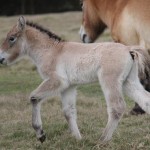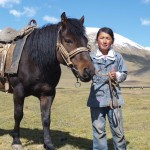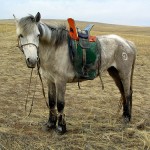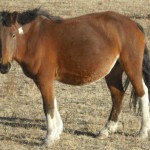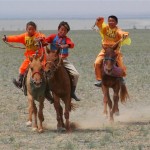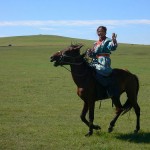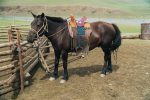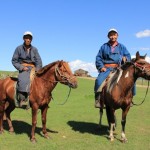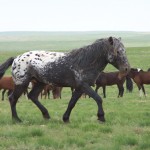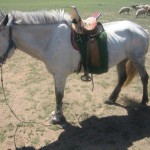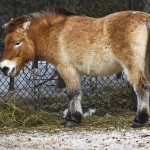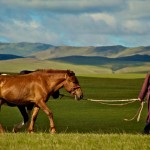Mongolian Horse
The Mongolian horse has been an integral part of the Mongol culture since time immemorial. Though categorized as horses, in terms of size they resemble a pony. They have a stocky build and are capable of living outdoors all year round under extreme weather conditions. Showing diverse talents, they are a popular choice among horse owners in the present times.
Mongolian Horse Pictures
- Baby Mongolian Horse
- Mongolian Horse Images
- Mongolian Horse Photos
- Mongolian Horse Pictures
- Mongolian Horse Race
- Mongolian Horse Riding
- Mongolian Horse
- Mongolian Horses Pictures
- Mongolian Horses
- Mongolian White Horse
- Mongolian Wild Horse
- Pictures of Mongolian Horse
Quick Information
| Temperament / Personality | Calm, reliable and friendly (after being accustomed to the rider). |
| Physical Characteristics | Short, stocky build, strong legs, large head, strong and hard hooves |
| Colors | Dun, Black, Bay, Shun, White, Brown, Roan, Grey, Palomino |
| Common Use | General riding, hunting, endurance riding, racing, mounted athletics like polo, racing and for work. |
| Life Span/ Life Expectancy | 20 to 40 years ( working till they are 18 years old) |
| Weight | Can weigh about 600 pounds (272 kg) |
| Height (Size) | 12 to 14 hands (48-56 inches; 122cm to 142 cm) |
| Health | Generally healthy with no known breed-related ailments. |
| Gaited | Yes (Mostly decides his own gait while the rider is engrossed in other chores like tending cattle). [1] |
| Popular Traits | Athletic, strong, energetic, requires low maintenance |
| Feeding/Diet | Mostly eat tall grasses and hay along with foliage, fruit, bark and plants with a rough texture. Drinks less amount of water or even eats snow in winter when in the wild. |
| Country of Origin | Mongolia |
| Year/Time of Development | Though the exact date of development of these traditional horses has not been known, they gained prominence in the 13th century. |
| Breed Information | Has not yet been recognized by any breed organizations. |
Mongolian Horse Video:
History
The Mongol horses were known to play a pivotal part in the 13th century, acting as Genghis Khan’s war steeds. Their energy, hardy nature, self-sufficiency and ability to find food on their own made them brilliant warhorses with the only disadvantage of being slow in comparison to the other breeds present in the battlefield. The soldiers also immensely depended on them to fulfill their daily requirement of food and milk, even going to the extent of drinking their blood during tough and stressful times. The war horses were so obedient to their masters that they would come instantly on hearing their whistle, following them loyally just like dogs. Mongol horse archers during Genghis Khan’s time were highly adept at defending their enemies while on horseback.
The nomads in the Central Asian steppes began riding on horsebacks as early as 2000BC though the exact date of origination of this breed is not known. Studies have shown that the Mongolian horses have the maximum genetic variation after which comes the Tuwinian horses. Attempts had been made to create faster horses by carrying out a breeding program between these native Mongolian horses and those belonging to a foreign race like thoroughbreds and Arabian horses. However, this did not bring in much success as these breeds were unable to cope up with the adverse weather conditions like their Mongolian counterpart. Moreover, crossing the Mongolian mares with a foreign stallion leads to large foals that may be problematic for the small mares to deliver. On the other hand, a foreign mare crossed with a male Mongolian result in producing a lesser number of foals.
Many horse breeds of Japan such as Taishu, Tokara, Kiso, Misaki, Myako, Hokkaido and Noma are said to derive their ancestry from them. These horses also have links with the breeds of Scandinavia, Central Europe, Iceland and the British Isles. In fact, the Icelandic horse has a striking resemblance to this breed as far as its livelihood and gathering food on its own is concerned.
Interesting Facts
- Though the Mongolian horse canters most of the time while on the move, it may occasionally display an ambling gait giving the impression that it is gliding on ice smoothly.
- In spite of their small body stature, they have immense stamina, being able to gallop for about 10 km at a stretch [1].
- Having a close resemblance to the Przewalski’s horse, this breed was thought to be of the same subspecies of the latter though this theory was proved to be incorrect in 2011.
- One of the chief attractions of Nadam, a traditional festival of Mongolia is horse racing where this breed is widely used for races covering a distance of 15km to 30 km.
- People also value them for their hair, used for making violin bows, rope, ornaments and fiddle strings while their meat is considered to be very healthy and delicious. The mare’s milk is used for preparing traditional drinks of ‘airag’ and ‘kumi’.
- They thrive outdoors at a temperature of 30°C


